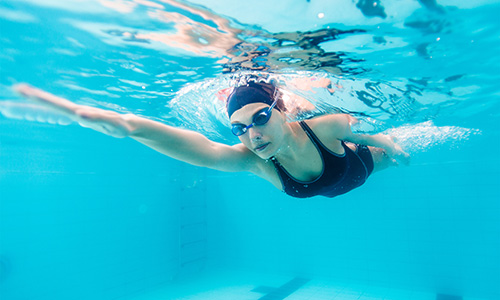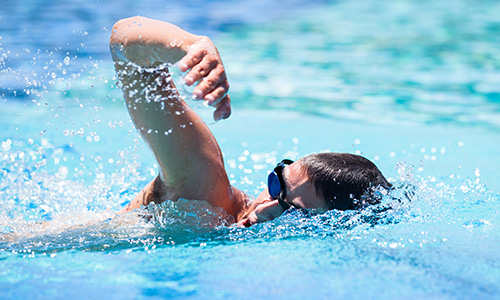How to swim front crawl correctly
- Overview
- Full article
The basics of learning to swim can be applied to every stroke that you learn. These simple principles focus on:
Body
Legs
Arms
Breathing
Each of these stages can't be performed effectively without first perfecting the previous stage. I'm going to tell you how to get each of these stages right with the front crawl, which is also the most common stroke used in freestyle events.
BODY
Your body should be flat and horizontal in the water with your shoulders and hips all inline.
To help you maintain a good body position keep your head in a neutral position in line with your body in the water. The water line should sit just above your goggle height and you should look down into the water and slightly in front. If you look too far down you'll bury your shoulders and create drag in the water.
LEGS
Your head position will also help to encourage the correct leg position, which is up near the surface of the water.
Now you can concentrate on your kick. If you're swimming correctly, the majority of your propulsion will come from your arms, rather than your legs. But there's more to kicking than just the push. You still need an 'effective' kick that will help to give you a good body position, reduce drag, drive your body's rotation and minimise the energy used.
In front crawl you will need your legs close together, straight but not locked out, toes/feet pointed (plantar flexion) and, most importantly, kick from your hip, not your knee.
Kicking at some speed will help to prevent your body from over-rotating.
ARMS
Your arm motion is crucial as this is where you get most of your propulsion from.

To do the front crawl arm stroke your thumb should always enter the water first with your hand at a 45 degree angle.
Your arm will twist as you pull your hand back through the water, creating a paddle underwater. You'll pull the water back all the way to your hip before the arm exits the water.
As your arm exits the water your elbow will bend up towards the ceiling and your hand will exit the water pinkie first.
BREATHING
Breathing tends to be the part of the stroke that most people struggle with, but once you've mastered your breathing, you'll feel much more confident in the water.
Your breathing style in front crawl comes down to personal preference. You can either take a breath every two or four strokes for lateral breathing (one side) or every three or five strokes for bi-lateral breathing (two sided).
Start to turn your head to the side when your arm is halfway through the pull stage and your head and hand should exit the water at the same time. You only need to turn your head enough so that your mouth is out of the water - the side of your head and one eye will still be in the water. Make sure your head is back in the neutral position before your other hand enters the water.
Your breathing style will also depend on the distance you swim:

Long distance: Trickle breathing is most common for longer distance swimmers. This is where you breath out slowly whenever your face is in the water and breathe in when your face is out the water. This keeps a continuous flow of oxygen coming in to your body.
Short distance: Explosive breathing is more common for shorter distances or sprints. This is where you hold your breath when your face is in the water then just before your face comes out of the water you breathe everything out. When your face is out of the water you then breathe in the same as you would on trickle breathing. Because when you hold your breath lactic acid builds up in your body, this breathing is no good for long distances.
Never attempt a swimming stroke for the first time on your own. Expert instruction is available at all Nuffield Health swimming pools.
Last updated Monday 6 November 2017
First published on Monday 5 September 2016

